There are 58 lizards you may come across in Texas from the small and common green anole to house geckos and skinks.
If you are wondering what lizard you just saw in your yard, then continue reading to find out more about the twenty common lizards in Texas.
Table of Contents
Are There Poisonous Lizards In Texas?
The lizards you come across in Texas are no poisonous, but they do carry disease. So if you just caught a lizard in the home or your child just brought in a lizard, ensure you wash hands thoroughly before touching your face or any surface.
Lizards spread salmonella, which can be transferred through touching the lizard, their droppings, or even cleaning or touching their environment.
Lizards In Texas
1. Green Anole

Scientific name: Anolis carolinensis.
Common name: Green anole, Carolina anole, Carolina green anole, American anole, American green anole, North American green anole, red-throated anole, American chameleon.
The green anole is a common lizard that is medium in size with a slender body and a long head.
Males develop a large throat that is three times the size of a female. Males’ throats or dewlaps are also bright red, females tend to remain pale pink to white.
Males also have a dorsal ridge which is prominent just behind the head, which will be displayed if he feels stress or threatened.
The adult male can grow up to eight inches (20cm) in length, up to seventy percent is made up of tail.
2. Texas Spiny Lizard

Scientific name: Sceloporus olivaceus.
Common name: Texas spiny lizards.
Texas spiny lizards grow to around eleven inches (28cm) in total length, including their tails.
They are light gray with black, red, or white patches on their backs with their patterns varying based on location. The pattern is an excellent camouflage against tree bark.
Their belly is light gray, though males may have some blue patches on their stomachs.
These lizards prefer habitats with trees and plenty of leaf litter. They can be found on the fence in urban areas, basking in the sun. They are nervous lizards and will run up a tree or run for leaf litter if approached.
3. Mediterranean House Gecko

Scientific name: Hemidactylus turcicus.
Common name: Mediterranean house gecko.
The Mediterranean house gecko is a small lizard that is light brown to tan in color with darker spots and a translucent underbelly.
They have a rounded snout and can be found on their own or in a group of five or more.
They are nocturnal and if approached they will run for the darkness in order to escape.
These geckos can lose their tails and regrow them, using them as a way to distract predators while they flee.
4. Brown Anole

Scientific name: Anolis sagrei.
Common name: Brown anole lizard, Cuban brown anole, De la Sagra’s anole.
Brown anoles are light brown with dark brown markings on their backs, along with light color lines on the sides. The anole is able to change color from dark brown to black, based on its environment.
The dewlap (throat flap) ranges in color from bright orange/red to yellow.
Males grow to around eight inches (20cm) in total length, though there are some species that have grown to nine inches. Females are smaller, growing to 5.9 inches.
Further Reading:
5. Common Spotted Whiptail

Scientific name: Aspidoscelis gularis.
Common name: Common spotted whiptail.
The common spotted whiptail, also known as the Texas spotted whiptail, can grow up to eleven inches (28cm) in total length.
They are green/brown or tan in color with seven gray or white stripes that run all the way down the body, stopping at the tail.
They have light color spots on their sides. The belly is white with males having a red throat and a blue belly with blue or black spots on their chests.
The tail is long and usually two thirds the length of the body.
These lizards live on insects and are very active.
They are ground in a host of habitats including grasslands, canyons, and never far from water.
Further Reading:
6. Little Brown Skink

Scientific name: Scincella lateralis.
Common name: Little brown skink, ground skink.
The little brown skink is one of the smallest reptiles in the United States, growing up to 5.5 inches (14.5cm) in total length, including the tail.
They are copper in color with white to yellow on their belly.
They have elongated bodies and short legs.
The little brown skink lives in a host of habitats including hedge grows, forests, on the edge of streams and ponds.
They prefer a deep layer of leaf litter to hide in.
7. Texas Horned Lizard

Scientific name: Phrynosoma Cornutum.
Common name: Texas horned lizard.
This Texas horned lizard is the largest bodies of the horned lizards in the United States, growing up to 2.7 inches (6.9cm) from snout to vent with females growing up to 4.5 inches (11.4cm) in total length and males up to 3.7 inches (9.4cm) in total length.
These are docile lizards and enjoy basking in the sun. You often see these lizards on the side of the road lying in the sun.
They bury themselves in the sand at night.
They don’t move much, but when they do, they are fast and will head for thick grass to escape.
8. Greater Earless Lizard
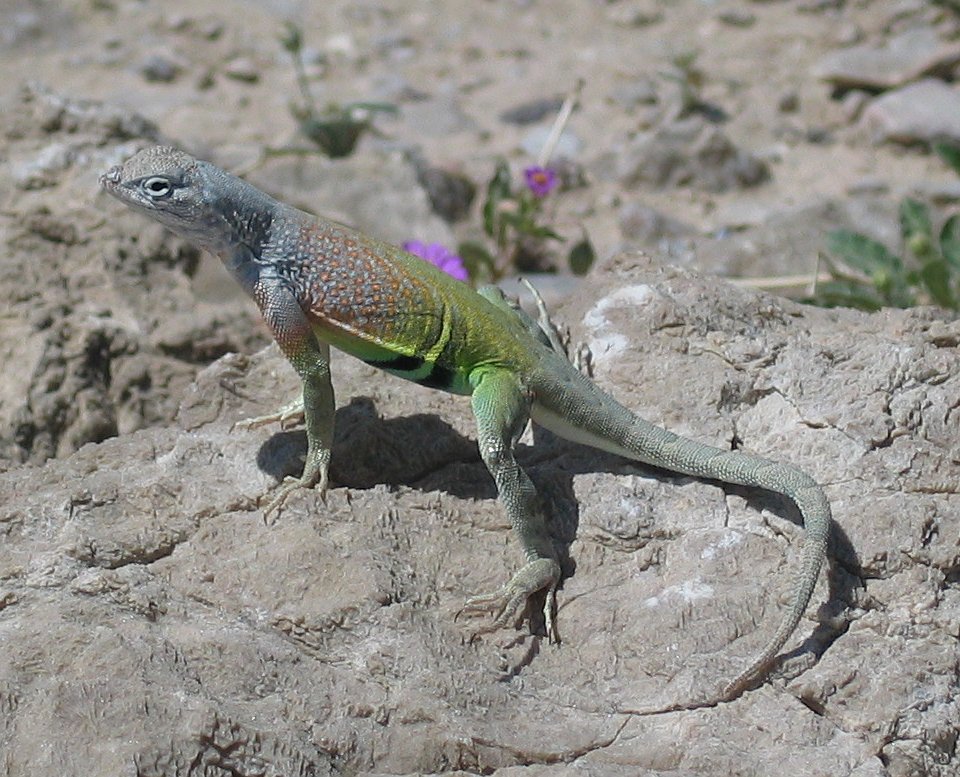
Scientific name: Cophosaurus texanus.
Common name: Greater earless lizard.
The greater earless lizard can grow up to seven inches (17.8cm) in total length with the males being larger than the females.
Males have two black stripes just before the hind legs, while females have a black stripe behind each thigh.
They have two throat folds and large eyes with short legs with long toes.
The greater earless lizards are active during the day, hibernate in winter, and will break their tail if approached by a predator, in order to escape.
9. Slender Glass Lizard

Scientific name: Ophisaurus attenuatus.
Common name: Slender glass lizard.
The slender glass lizards have brown to yellow-colored bodies with six stripes and a middorsal stripe.
They have white specks on the middle of the scales.
Their total length can be up to 36 inches (90cm) with the tail taking up two thirds of that length.
These are not snakes and have ears and eyelids, though they do struggle on smooth surfaces due to not having a belly plate, as snakes do.
10. Rose-bellied Lizard

Scientific name: Sceloporus variabilis.
Common name: Rose-bellied lizard.
Rose-bellied lizards are small lizards growing up to 2.1 inches (5.4cm) snout to vent. If the tail has not been broken, it can reach 5.5 inches (14cm) in total length.
They have an olive or tan base color with dark brown spots and two yellow stripes, one on either side of the back.
Males tend to be darker below the stripe. Males have a large pink spot on either side of their tummy, bordered by blue.
11. Common Five-lined Skink

Scientific name: Plestiodon fasciatus.
Common name: American five-lined skink, common five-lined skink.
The common five-lined skink, also known as the American five-lined skin, is a medium-size lizard growing up to 8.5 inches (21cm) in total length, including the tail.
The juveniles are dark brown with five yellow to white stripes along the body, complemented by a bright blue tail, which fades with age.
These skinks prefer wooded habitats that have ample cover and places to bask in the sun.
Further Reading:
12. Ornate Tree Lizard
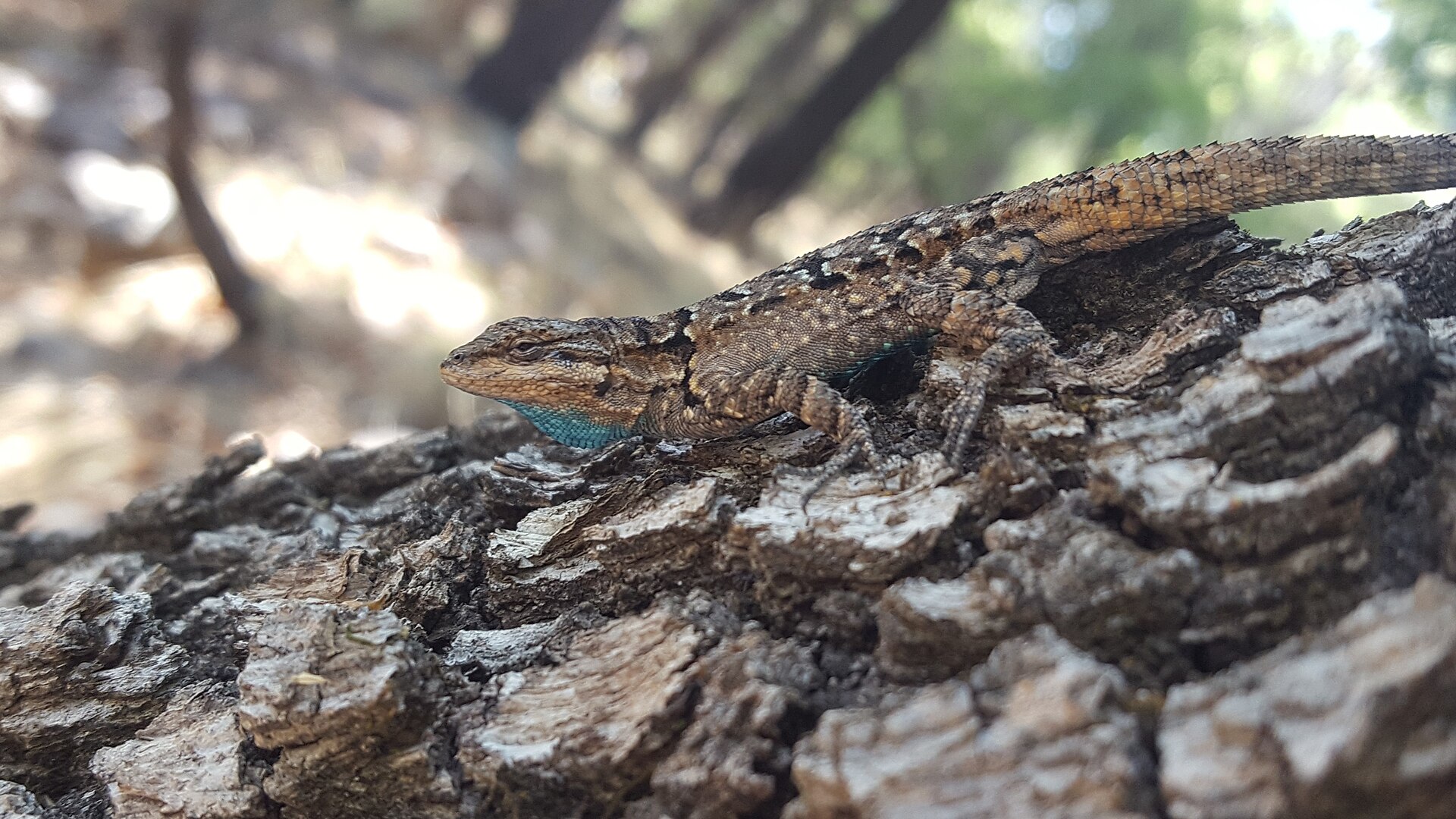
Scientific name: Urosaurus ornatus.
Common name: Ornate tree lizard.
These lizards grow up to 2.3 inches (5.9cm) from their snout to their vent.
Males have turquoise patches on their abdomen, which females do not have.
Males come in a range of colors, though most populations only have one or two colors.
Some of the colors noted include an orange patch on the throat fan with a blue spot in the center, these males tend to be more aggressive than those that are plain orange, leaner and longer.
13. Crevice Spiny Lizard

Scientific name: Sceloporus poinsettii.
Common name: Crevice spiny lizard.
The crevice spiny lizard is a gray lizard that may have some red to brown color with white or black collar around the neck. They are light gray on the underside, though males do have a blue patch on either side of their tummy.
These lizards grow up to 12.2 inches (31cm) in total length, including the tail.
They are very shy and nervous lizards that will run to a crevice if approached.
They can be found in holes and crevices, usually in limestone rock.
14. Prairie Lizard
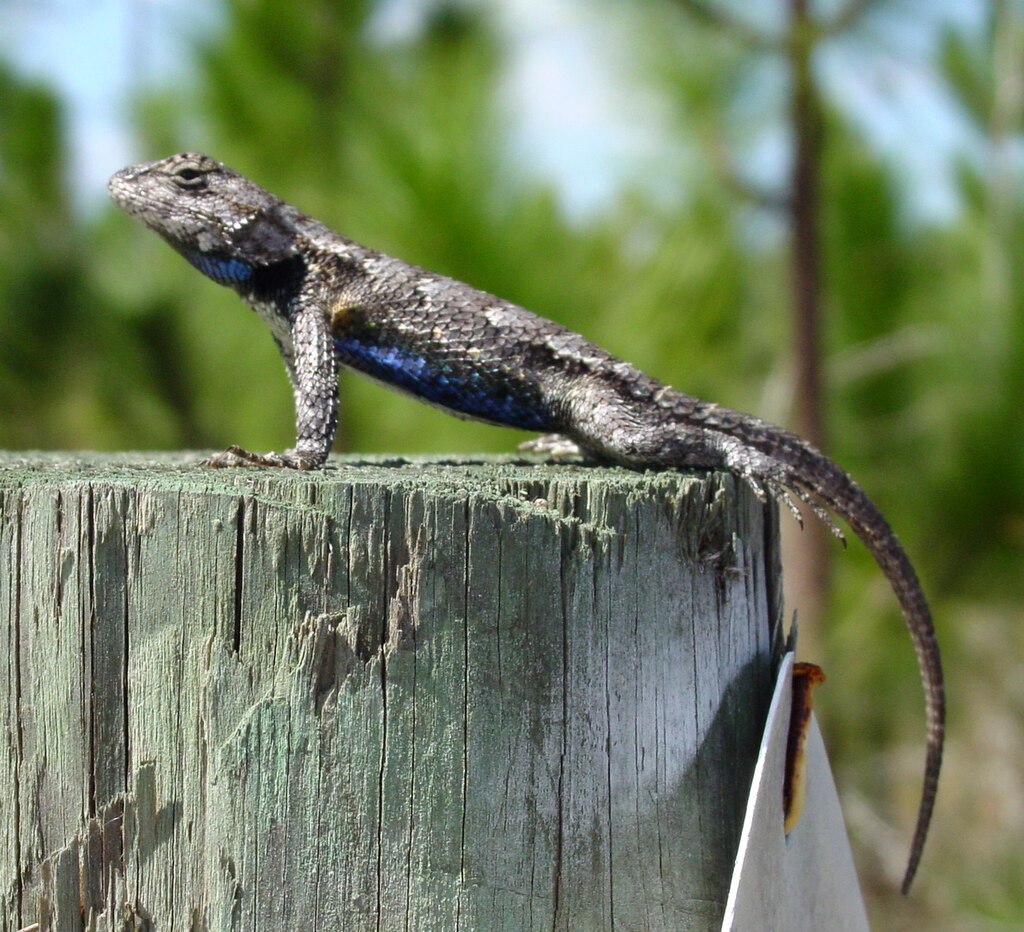
Scientific name: Sceloporus Undulatus.
Common name: Eastern fence lizard, prairie lizard, fence swift, gray lizard, northern fence lizard, pine lizard.
Prairie lizards are small brown to gray lizards with rough scales, reaching total lengths of around five inches.
This lizard’s color will vary on its sex with males usually brown or dark gray with no pattern, but blue tummies and throats.
Females have wavy lines on their backs and some orange or red coloration at the base of their tails. Their bellies are white and may have some faint darker spots.
These lizards run up trees if approached in order to escape from predators.
15. Keeled Earless Lizard

Scientific name: Holbrookia propinqua.
Common name: Keeled earless lizard.
The keeled earless lizards have small and pointed dorsal scales. An adult will grow up to 5.5 inches (14cm) in total length.
They are found in a host of habitats from oak forests to cleared fields, coastal plains, and grasslands. They prefer sandy streamside areas and are often found in loose sand.
16. Eastern Collared Lizard

Scientific name: Crotaphytus collaris.
Common name: common collared lizard, eastern collared lizard, Oklahoma collared lizard, yellow-headed collared lizard, collared lizard.
The Eastern collared lizard can grow up to fifteen inches (38cm) in total length. They have large heads and powerful jaws with males having a brown head and green/blue body.
Females also have a light brown head, but their body is the same brown.
These lizards can be found in open and dry regions, including Texas, New Mexico, Arizona, and Kansas, for example.
17. Six-lined Racerunner

Scientific name: Aspidoscelis Sexlineatus.
Common name: Six-lined racerunner.
The six-lined racerunner is brown, black, or dark green in color and has six green/yellow to yellow stripes that run from the head down the tail.
Females have a white tummy, while males have a pale blue tummy and pale green dewlap.
They are slender and their tails are two thirds their body size.
These lizards are active in the day, preying on insects, they are also very wary and shy and will flee at fast speeds of up to 29 kilometers per hour (18mph) to get to cover and hide.
Their habitats range from woodlands and grasslands to rocky outcrops and open floodplains.
18. Common Side-blotched Lizard

Scientific name: Uta stansburiana.
Common name: Common side-blotched lizard.
This is a small lizard with males growing to 2.4 inches (6cm) from snout to vent.
Females are smaller than males with pigmentation varying between populations and sexes.
Males sometimes have blue on their backs and tails with yellow sides, while others may not have any pattern.
Females can have stripes down their backs.
Both sexes have a noticeable blotch on their sides.
19. Broad-headed Skink

Scientific name: Plestiodon laticeps.
Common name: Broad-headed skink, broadhead skink.
The broad-headed skink is one of the largest skinks which can grow up to 13 inches (33cm) in total length.
They have wide jaws, triangular-shaped heads and can be found in urban areas to forests, with plenty of leaf litter.
Males are olive to brown in color with orange heads during mating season. Females have five stripes that run down the back and tail.
Juveniles display a bright blue tail, which fades with age.
These skinks live in trees and on the ground.
Further Reading:
20. Four-lined Skink
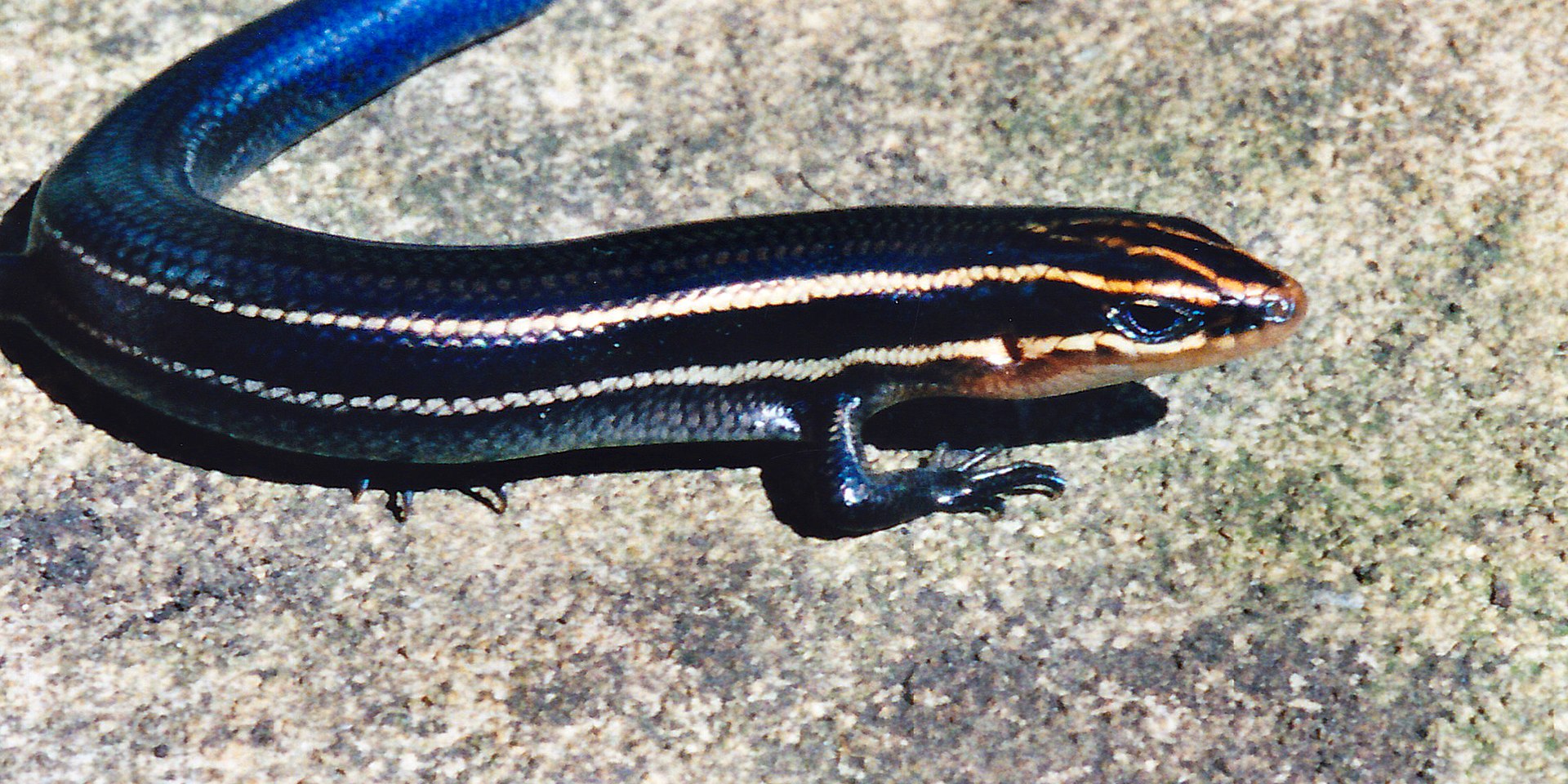
Scientific name: Plestiodon tetragrammus.
Common name: Four-lined skink.
There are two subspecies of the four-lined skink both distinguished by their stripes and coloration.
Some are gray or light brown with stripes that extend from the eyes to past the forelegs, these are the long-lined skinks.
The short-lined skinks are darker in color and their stripes stop before the forelegs.
Juveniles have blue tails, which fade with age. Adults can grow up to 7 inches (18cm) in total length.
They prefer wooded and rocky areas with long lined skinks often being seen in grasslands.
21. Canyon Lizard

Scientific name: Sceloporus merriami.
Common name: canyon lizard.
Canyon lizards can grow to 2.2 inches (58mm) from snout to vent and 6.4 inches (162mm) including their tails.
They are gray, red/brown, or tan in color, helping them blend into the rocks where they prefer to live. They have four rows of spots on their backs, along with a vertical line in front of their front legs.
Males have blue and black lines on their throats.
22. Southwestern Fence Lizard

Scientific name: Sceloporus cowlesi.
Common name: southwestern fence lizard, Cowles’ prairie lizard, White Sands prairie lizard, White Sands swift.
Southwestern fence lizards are small lizards, growing to around 75mm, excluding their tails. Their tail is the same length as their body.
They are brown, tan, or gray in color with a light stripe on both sides. They are dark when cold and lighten in color as they warm up.
Males have blue on both sides of the abdomen and their throats are usually edged with black.
23. Blue Spiny Lizard
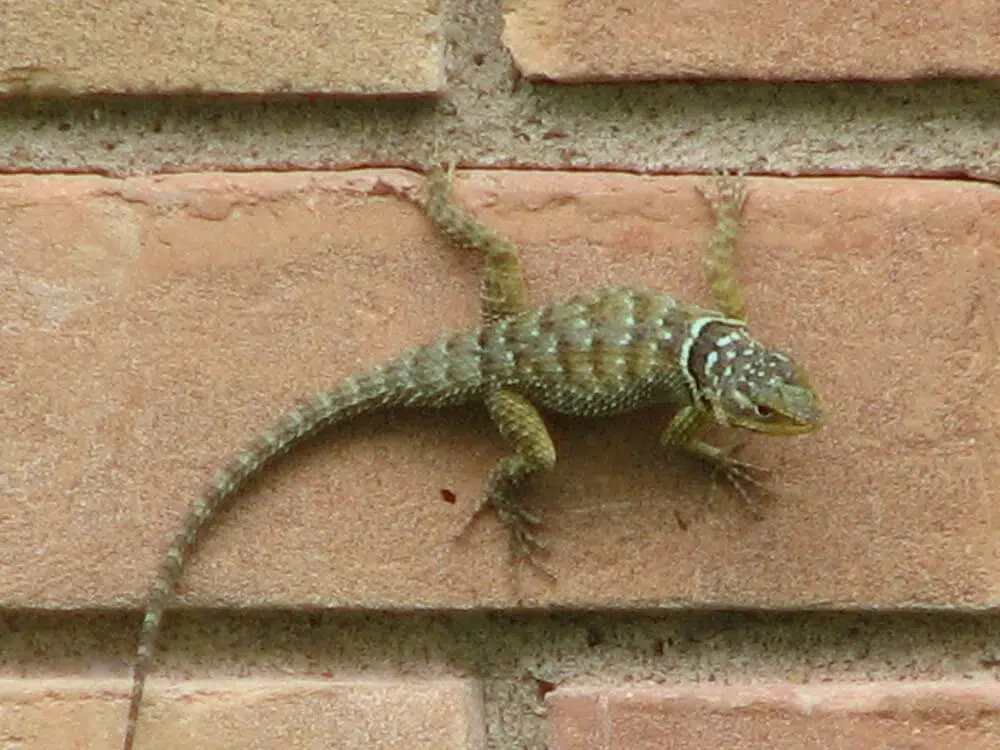
Scientific name: Sceloporus cyanogenys.
Common name: Blue Spiny Lizard.
Blue spiny lizards can grow up to 14 inches.
Their color is determined b their age, season, temperature, and time of day, but are usually brown to gray with cross bands. During the day, they have a blue sheen with a large black collar that has a light ring on both sides of the neck.
They have a cream belly and males have two blue areas on both sides of the belly and on their throats.
They have long tails, which can be used as a defense. The tail comes off easily and continues to wriggle, keeping predators occupied while the lizard escapes.
Even though they are able to regenerate their tails, they never grow back as colorful or as long as before.
24. Texas Banded Gecko
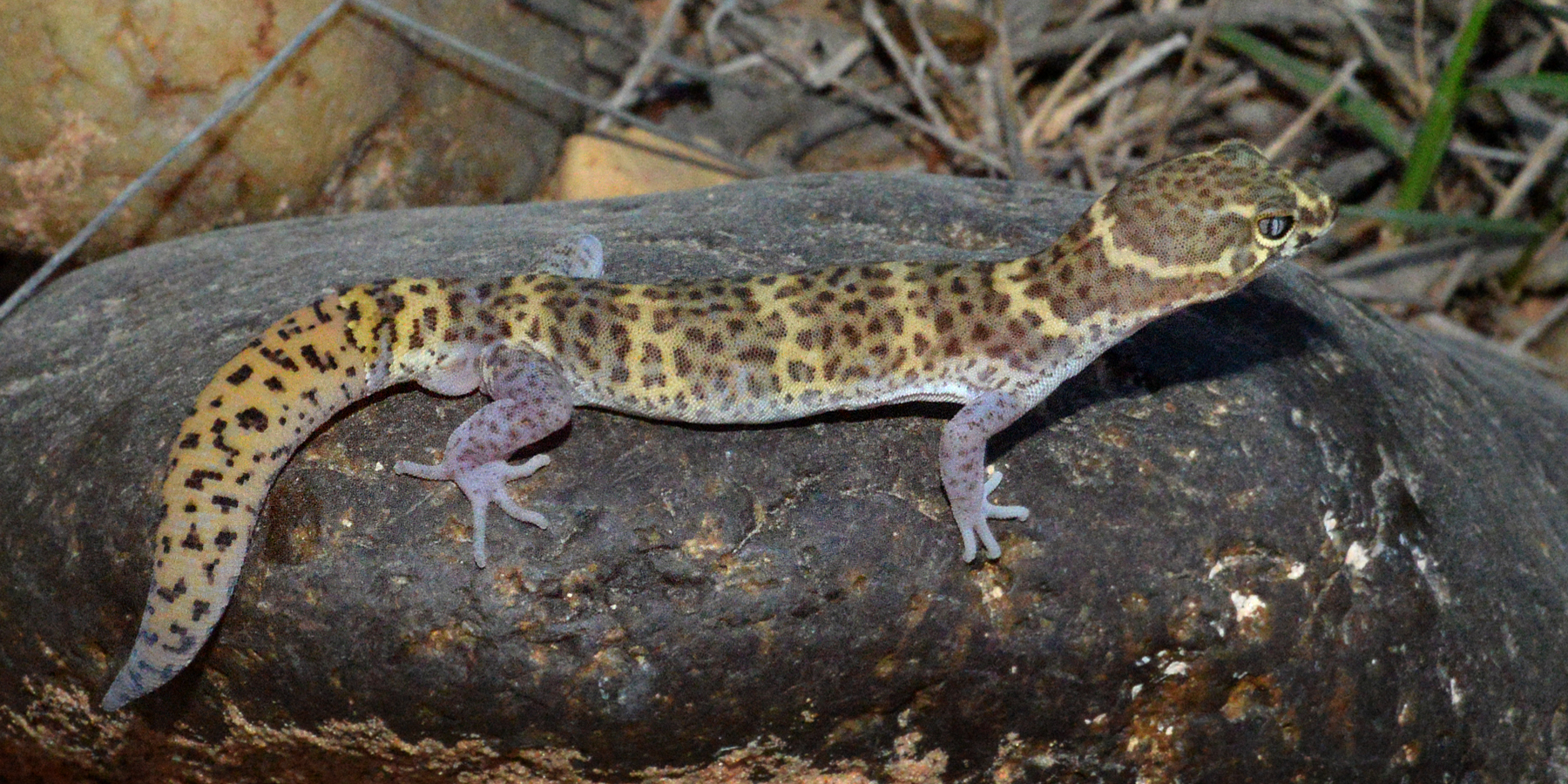
Scientific name: Coleonyx brevis.
Common name: Texas Banded Gecko.
These are small lizards that grow to around 4 inches (10cm) in total length. They have bands of yellow and brown with black accents.
They prefer semi-arid areas and are often found in canyon crevices and in rock piles.
They are nocturnal lizards that consume small arthropods.
25. Texas Alligator Lizard

Scientific name: Gerrhonotus infernalis.
Common name: Texas Alligator Lizard.
The Texas alligator lizard is a medium lizard that can grow to 25 inches (64cm) including the tail.
They are one of the largest alligator lizards in the world and have flat heads, yellow to brown bodies with a dark brown and white checkered pattern.
They have short limbs and a tail which can break off and regenerate, helping to distract potential predators, giving the lizard time to escape.
These are not fast lizards and are not aggressive.
Though they will bite if captured.
26. Gray-checkered Whiptail
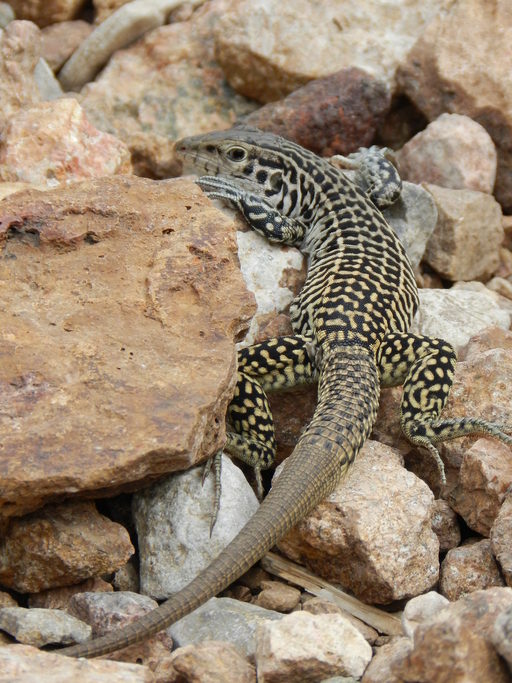
Scientific name: Aspidoscelis tesselatus.
Common name: gray-checkered whiptail, checkered whiptail, common checkered whiptail.
Gray checkered whiptails can grow up to 12 inches (30cm) including the tail.
They are gray in color with around ten to twelve white or yellow stripes that run the length of the body with checkers on the stripes.
They are slender with long tails.
They are energetic and fast-moving and very wary and will run for cover if you get too close.
They are often seen in semi-arid areas with very little vegetation and rocks, which gives the lizard place to hide.
27. Roundtail Horned Lizard
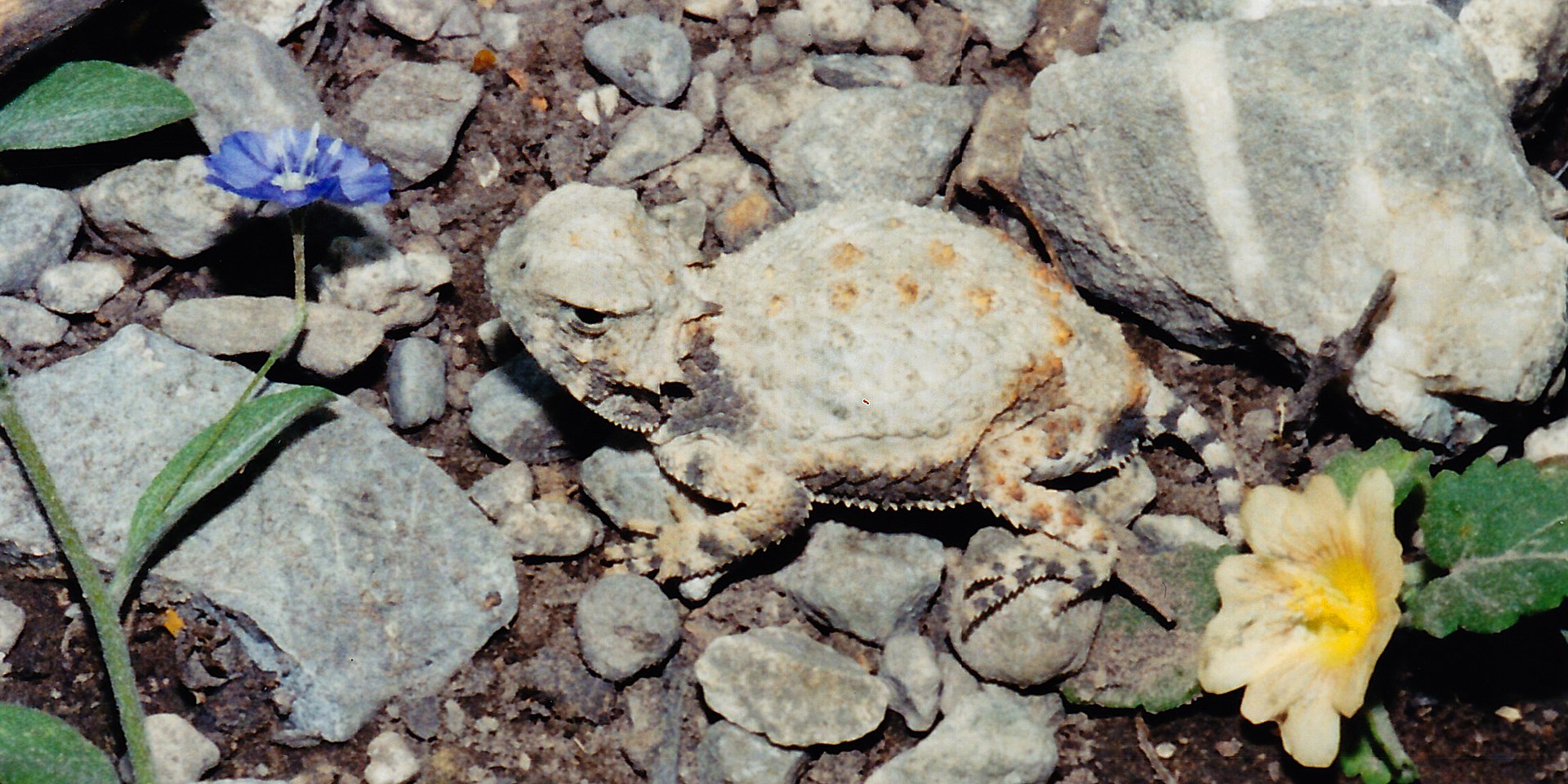
Scientific name: Phrynosoma modestum.
Common name: Roundtail Horned Lizard.
These lizards are happiest when they are in a rocky and sandy habitat with limited vegetation, they are usually found near harvester ant and honeypot ant colonies.
Their base color is often the same color as the soil where they live, they are mostly gray or light brown, some are a pale yellow. They have darker colors near the groin and neck, along with some striping on the tail.
These are short and fat lizards with small heads, short limbs, and a crest of equal length horns.
In order to hide, they hunch themselves up to mimic a rock as camouflage.
Their body length can reach up to 4.3 inches (10.5cm) including the tail.
28. Chihuahuan Spotted Whiptail

Scientific name: Aspidoscelis exsanguis.
Common name: Chihuahuan Spotted Whiptail.
The Chihuahuan spotted whiptail can grow up to 12 inches in length and is red to brown in color with six light stripes that run the full length of the body. There are spots between the stripes. They have a white to pale blue belly.
They are very slender lizards with a tail that is almost three times the length of the body.
29. Great Plains Skink

Scientific name: Plestiodon obsoletus.
Common name: Great Plains Skink.
Great plains skinks can grow to 34cm in total length, including the tail.
They are beige to light bray with black or brown edges on their dorsal scales.
They have a yellow belly and juveniles have black and white on their head and lips with a blue tail.
This lizard prefers an open plains habitat, which is close to a permanent water source.
Further Reading:
30. Spot-tailed Earless Lizard
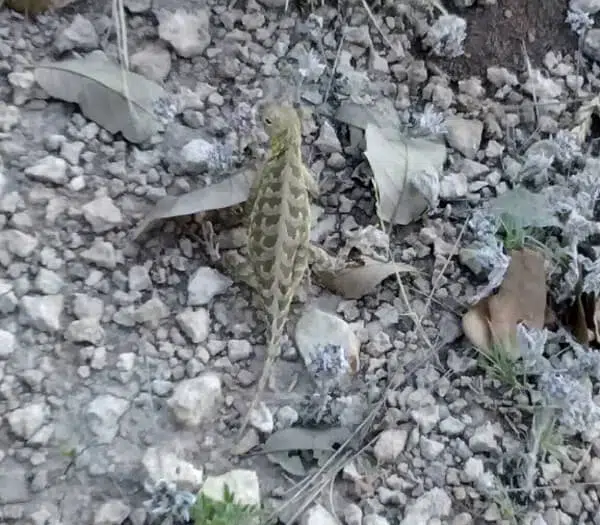
Scientific name: Holbrookia lacerata.
Common name: Spot-tailed Earless Lizard.
This lizard does have ears, but there are no external ear openings, enabling it to burrow in the sand.
They live in open meadows with low grass and shrubs. They are often observed in central and southern Texas.
31. Marbled Whiptail
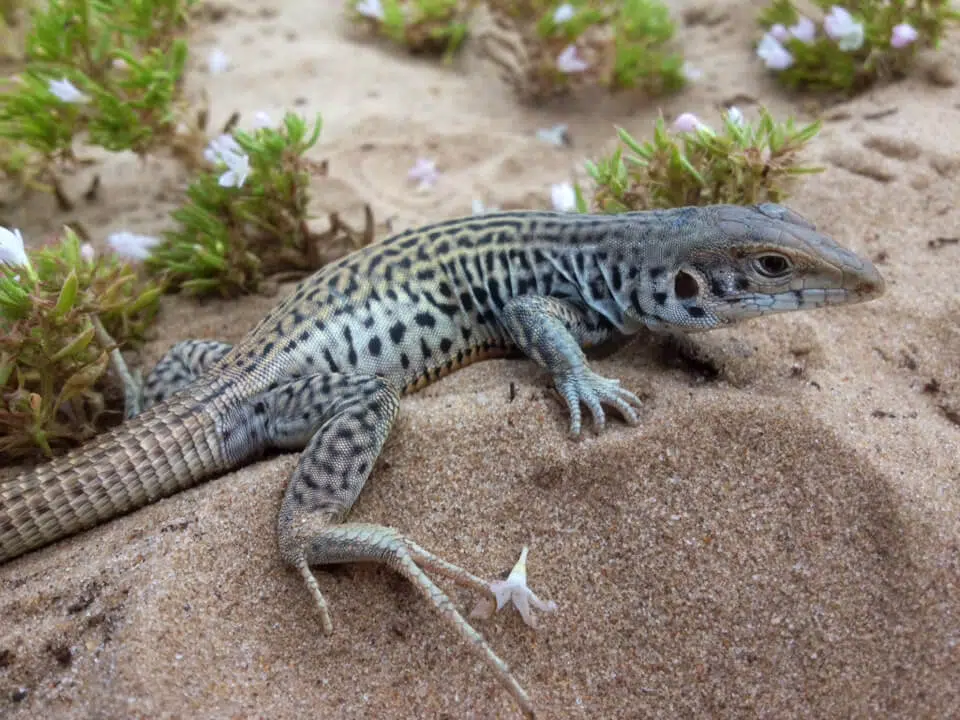
Scientific name: Aspidoscelis marmoratus.
Common name: Marbled Whiptail.
Marbled whiptails can grow up to twelve inches in length and are gray or black in color with four to eight yellow to white stripes and dark mottling, which gives this whiptail its marbled appearance.
They have a pale yellow to white belly with some peach color on the throat.
They have long tails and slender bodies.
They are highly energetic and fast-moving and will run for cover if approached.
Juveniles look like adults but with a bright blue tail that fades as the lizard gets older.
32. Little Striped Whiptail

Scientific name: Aspidoscelis inornatus.
Common name: Little Striped Whiptail.
Little striped whiptails can grow to 9.5 inches in length and are black in color with white to yellow stripes from the head to the tail with blue on the belly.
They are slender with the blue tail being around three times the body length.
Males have pronounced blue compared to females.
Not all of these lizards are striped and some are brown with dark patches, that helps them blend into their habitat.
They are very wary and fast-moving and will run for cover if approached.
33. Plateau Spotted Whiptail

Scientific name: Aspidoscelis scalaris.
Common name: plateau spotted whiptail, rusty-rumped whiptail.
This whiptail is one of the ten racerunners in Texas and is often observed in the Big Bend region.
They prefer rocky hillsides and canyon bottoms where there is sparse vegetation.
They are very wary and fast and will run for cover if approached.
They have six to seven light tan stripes on their backs with dark spots that appear randomly between the stripes.
The tail makes up 65% of the lizard’s total length.
Males have blue to black mottling on their belly and orange on their throats during the breeding season.
34. Lesser Earless Lizard
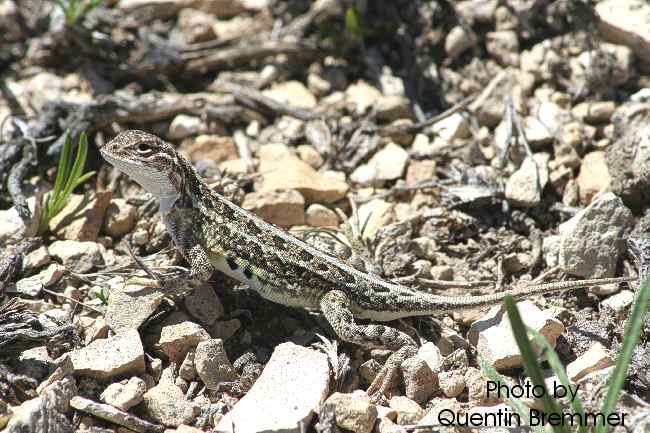
Scientific name: Holbrookia maculata.
Common name: lesser earless lizard.
The lesser earless lizard is a medium-sized lizard that grows to 5 inches (13cm) in total length.
They are light gray to gray-brown in color with a mottled tan or light brown markings that are mixed with dark patches. There are around fourteen dark spots on the back with pale stripes on the sides.
Their belly is white without patterns.
Their tail is short when compared to other lizards, usually the same length as the body.
During the breeding season, males have blue coloration around the black bars on the sides, while females develop orange on the sides.
They are often observed in flat habitats with plenty of sandy soil and sparse vegetation. They prefer sandy grasslands, sandhill prairies, dry sandbars, and agricultural fields.
35. Graphic Spiny Lizard
Scientific name: Sceloporus grammicus.
Common name: mesquite lizard, graphic spiny lizard.
This is a flat-bodied lizard with a tail that is longer than the body length, they can grow up to 6.9 inches (17.5cm) including the tail.
They are mottled gray or olive with up to six crossbars.
The tail and forelegs have narrow crossbars.
Males have blue patches on the throat and a dark line on the shoulder with some blue on the belly.
36. Greater Short-horned Lizard

Scientific name: Phrynosoma hernandesi.
Common name: greater short-horned lizard, mountain short-horned lizard,.
This lizard is often mistaken for the pygmy short-horned lizard.
This species can grow up to 5 inches (12.7cm) including the tail. Females are larger than males.
They are flat-bodied with a crown of scales on their heads. They have short legs and a snub nose.
They are red-brown, yellow, or gray with two rows of large spots on their backs. Their colors intensify when they feel threatened.
They are sit-and-wait predators and are often seen on trails. They are mostly active in the early evening, burrowing at night and relying on camouflage to protect them from predators.
They are able to build up blood pressure behind the eyes, which allows them to squirt blood at anyone or anything that attacks them.
37. Reticulate Collared Lizard

Scientific name: Crotaphytus reticulatus.
Common name: Reticulate Collared Lizard.
This is a brown to tan colored lizard with no color differentiation between males and females, except during mating season when males develop bright yellow on their chest and a green to gray dewlap.
Females, on the other hand, develop orange bars on the underside when gravid.
They can grow to 16 inches (41cm) including the tail.
38. Twin-spotted Spiny Lizard

Scientific name: Sceloporus bimaculosus.
Common name: Twin-spotted Spiny Lizard.
This is one of ten spiny lizards found in Texas and is limited in range in the state. They are often seen in the eastern Permian Basin and through to the Trans-Pecos region.
They are often referred to as tree or fence lizards and are found in wooded areas, usually under rock piles and woodpiles where they shelter from predators.
39. Reticulated Gecko
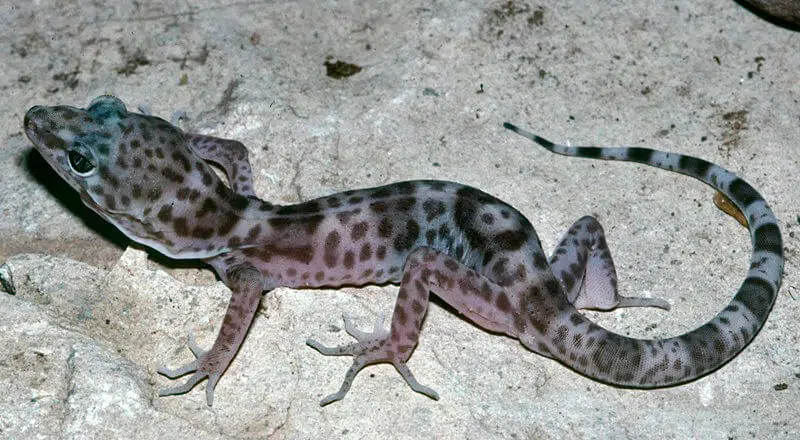
Scientific name: Coleonyx reticulatus.
Common name: reticulate banded gecko, reticulated gecko.
These banded geckos can reach 6.5 inches in length and are brown to pink in color with black to brown spots and some faint bands.
They are often mistaken for Texas banded geckos, sharing a habitat, but the Reticulated gecko is larger in size, resembling a leopard gecko.
They are nocturnal and found in rocky semi-arid areas. This lizard is listed as a threatened species in Texas.
40. Many-lined Skink
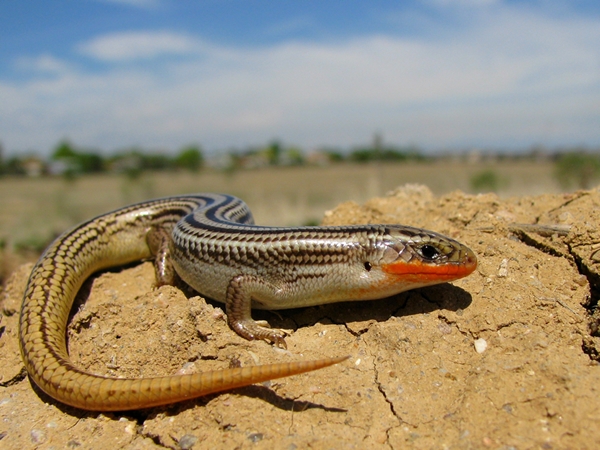
Scientific name: Plestiodon multivirgatus.
Common name: many-lined skink, the northern many-lined skink, the variable skink.
The many-lined skink is a medium-sized lizard that can grow up to 8 inches (20cm) in total length. Some are shorter due to their regenerated tails, which never fully grow back to their original size.
They are light gray to tan in color with black stripes running down their bodies. They have around ten stripes, but some may be more obvious than others.
There are two large black stripes on the back that taper as they get to the tail. They have small and thin limbs with tubular bodies. They have a pale cream belly.
Males develop an orange or red dewlap during the breeding season, helping to tell them apart from females.
Juveniles have bright blue tails which fade with age.
They prefer grasslands with sandy soils where they hide under logs and rocks.
41. Dunes Sagebrush Lizard
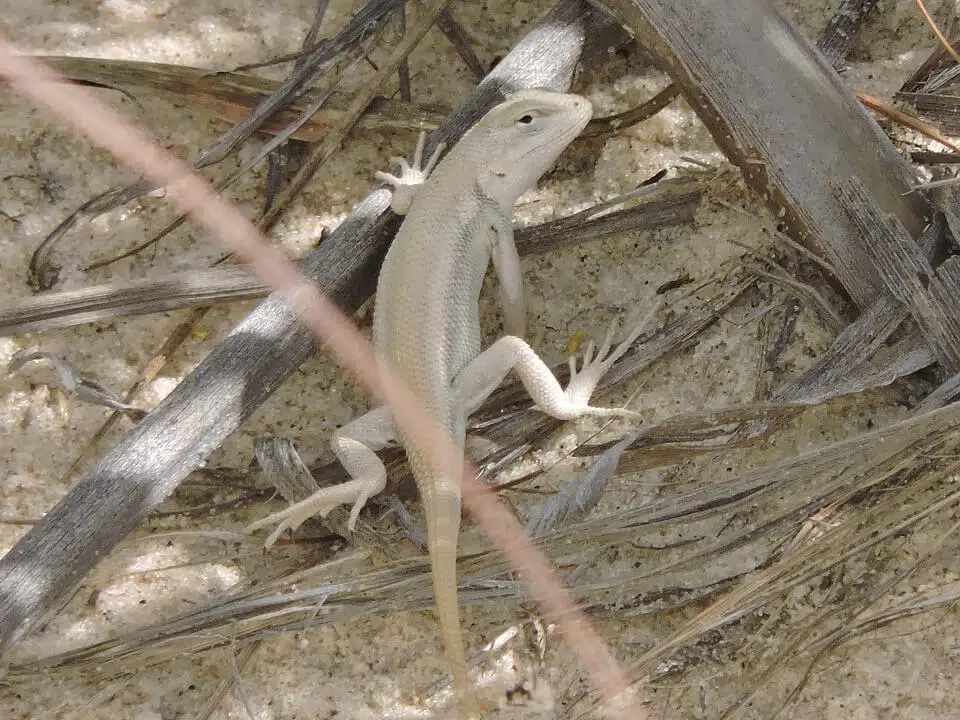
Scientific name: Sceloporus arenicolus.
Common name: Dunes Sagebrush Lizard.
Dunes Sagebrush lizards, also known as sand dune lizards, are very rare. They are active and found in semi-stable shinny oak dunes.
They are light brown with stripes on the body.
They are most active between April and October.
42. Laredo Striped Whiptail
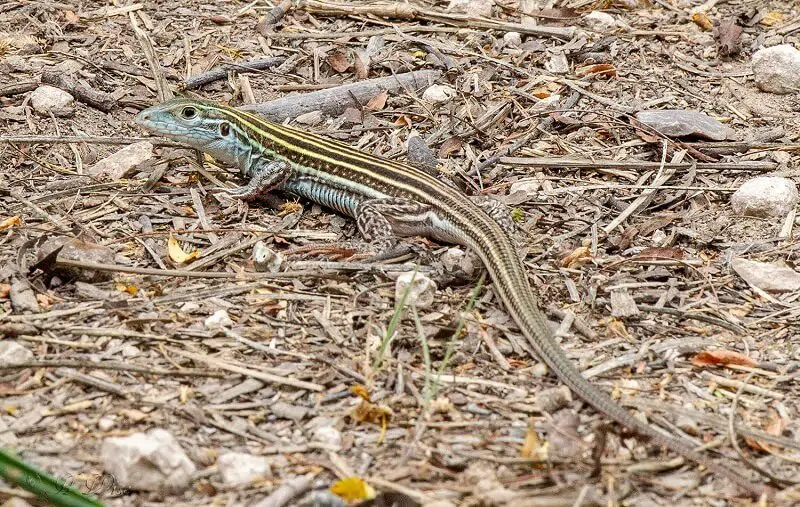
Scientific name: Aspidoscelis laredoensis.
Common name: Laredo Striped Whiptail.
This lizard can grow up to 11 inches in length and s dark brown to dark green in color with seven white or yellow stripes that run the length of the body with a white belly.
They have a long tail and are thin-bodied.
They are very energetic and fast and will run for cover if approached.
They are mostly observed in cultivated fields and pasture lands.
43. Western Spiny-tailed Iguana

Scientific name: Ctenosaura pectinata.
Common name: western spiny-tailed iguana, Mexican spinytailed iguana, spiny-tailed iguana, black spiny-tailed iguana, Guerreran Spiny-tailed Iguana, broad-ringed spiny-tailed iguana.
The Western spiny-tailed iguanas have long tails and can grow up to 4.3 feet (1.3m) in length.
Females are slightly smaller than the male.
They are brown or gray in color with yellow and a crest of spines that extend down their backs.
Juveniles are bright green and darken with age.
Some of them may have a piebald pattern on the dorsal areas and head and the tail may have cross banding.
Some males show yellow coloration and females show orange coloration.
44. Prairie Skink

Scientific name: Plestiodon septentrionalis.
Common name: Prairie Skink.
Prairie skinks are small and can grow to 9 inches (22cm) including the tail.
They are tan or brown with dark sides and light stripes on the sides and back.
Juveniles can be identified with their bright blue tail, which fades with age.
These lizards are excellent at burrowing and are secretive, very seldom seen in the open except in the spring, during their breeding season.
45. Keeled Rock Gecko

Scientific name: Cyrtopodion scabrum.
Common name: rough-tailed gecko, rough bent-toed gecko, rough-tailed bowfoot gecko, common tuberculate ground gecko, keeled gecko.
The keeled rock gecko is also referred to as the rough-tailed gecko, belonging to the Gekkonidae family. Originally from Asia, it was introduced to North America.
This secretive lizard is not often observed. Shy and fast, it runs from anyone approaching it, blending in with its surroundings.
46. Long-nosed Leopard Lizard

Scientific name: Gambelia wislizenii.
Common name: Long-nosed Leopard Lizard.
The long-nosed leopard lizard is white, gray, or cream with brown or dark spots on the head and body, some have bars on their backs.
Tails have dark bars with juveniles looking similar to adults with rust coloration on their backs with red spots and yellow thighs.
Females grow to around 5.8 inches (15cm) from snout to vent with males being smaller, at around 4.8 inches (12cm).
They are able to change color from dark to light, depending on the time of day. During the dark phase, their light crossbands become more obvious. In the light phase, the dominant colors are pink, brown, yellow, or gray.
Females develop red and orange spots during mating season, while males develop a rust or pink color on their throat and chest.
47. Tropical House Gecko

Scientific name: Hemidactylus mabouia.
Common name: tropical house gecko, Afro-American house gecko, cosmopolitan house gecko.
Tropical house geckos can reach a length of 5 inches (12.7cm) excluding the tail.
They are nocturnal and are able to slowly change their color from dark brown to light brown to blend in with their surroundings.
They reside in urban locations and are frequently seen in Texas homes.
48. Asian House Gecko

Scientific name: Hemidactylus frenatus.
Common name: common house gecko, Asian house gecko, Pacific house gecko, wall gecko, house lizard, moon lizard.
Asian house geckos are common house geckos in Texas, also known as the Asian house geckos.
They are nocturnal and are seen on the walls of houses and buildings looking for insects that are attracted to night lights.
They can grow up to 6 inches (15cm) in length and are not harmful to humans.
They prefer warm and humid areas and are very adaptable and robust.
49. Desert Grassland Whiptail

Scientific name: Aspidoscelis uniparens.
Common name: Desert Grassland Whiptail.
The desert grassland whiptail is a small lizard that grows to 13.3cm.
They are long, slender with a thin tail that is longer than their body length.
They have six yellow lines that run the length of the body, which are olive to brown in color with gray to blue on the tail.
Juveniles have a bright blue tail that fades with age.
50. Coal Skink

Scientific name: Plestiodon anthracinus.
Common name: Coal Skink.
Coal skinks can grow up to 7.1 inches (18cm) in total length with four light stripes that run onto the tail.
Males have red on the sides of their heads during breeding season.
Their lateral stripe is around 4 scales wide with no light stripe on the head.
51. New Mexico Whiptail

Scientific name: Aspidoscelis neomexicanus.
Common name: New Mexico Whiptail.
New Mexico whiptail lizards can grow to 9.1 inches (23cm) in length and are black or brown in color with seven yellow stripes that run from the head to the tail.
They have light spots between the stripes. Their bellies are white or pale blue and they have a blue-green or blue throat.
The New Mexico whiptail has a slender body and long tail.
They are very energetic, fast-moving, and wary. They will run for cover if approached.
They can be found in a range of habitats from grasslands and rocky areas to mountainous woodlands and shrubland.
52. Green Iguana

Scientific name: Iguana iguana.
Common name: green iguana, American iguana, common green iguana.
Green iguanas are herbivorous lizards that can grow up to 1.5 meters (4.9 feet) in length, including the tail.
There are some recorded to have grown up to two meters (6.6 feet) with a body weight of 9.1kg (20lb).
These lizards will try and flee if they are frightened and will swim away if near water.
You can easily tell when they are being defensive, they show their dewlap, they stiffen and puff up their body as they bob their head and hiss.
Their long tail is a weapon that they will whip you with before they bite. They also use their long claws to defend themselves.
53. Eastern Fence Lizard

Scientific name: Sceloporus undulatus.
Common name: prairie lizard, fence swift, gray lizard, northern fence lizard, pine lizard.
The Eastern fence lizard can grow up to 7.25 inches (18.5cm) in length.
It is a gray color but can range from black to brown.
Females have black patterns on their back, while males have blue on their belly and chins.
They can live just about anywhere and can be found on the coast and in mountainous areas.
They are one of the most tree-dwelling lizards you will find in Texas and will run for the nearest tree if approached.
If you pursue it, the lizard will stay on the opposite side of the tree, making it harder for you to capture it.
54. Southern Spot-tailed Earless Lizard
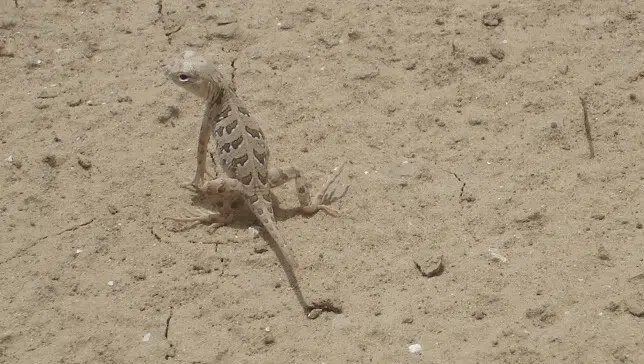
Scientific name: Holbrookia subcaudalis.
Common name: southern spot-tailed earless lizard.
Southern spot-tailed earless lizards are light gray to tan in color with dark blotches down both sides of the back.
Adults can grow up to 6.1 inches (15.4cm) in length, including the tail.
They have dark spots on the surface of the tail.
Females tend to turn a green to yellow color on their neck and trunk when they are gravid.
These lizards are often found in low rolling hills, small patches of grass, and mesquite trees.
55. Speckled Earless Lizard
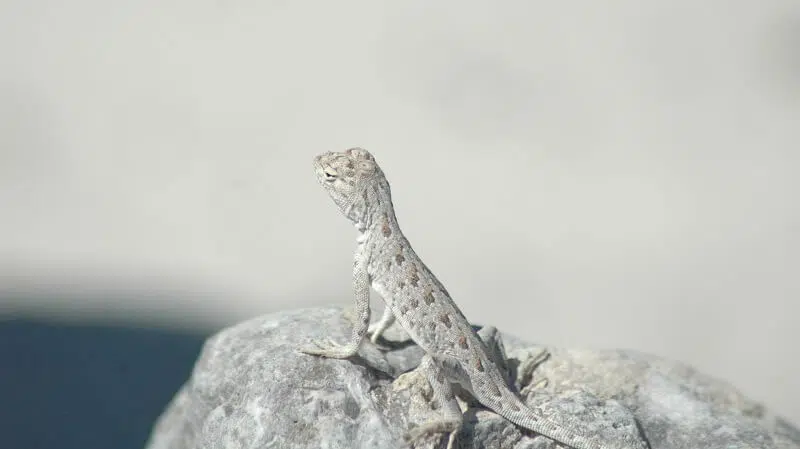
Scientific name: Holbrookia approximans.
Common name: Speckled Earless Lizard.
Speckled earless lizards are gray to brown in color with black and white patches on the back. Their belly and under the tail are solid gray or brown. They have black and white bars just behind the back legs.
Males have some blue to their white bars, where females remain a solid white.
They prefer grassland habitats where there is little vegetation.
They are nervous and will run and hide if approached.
56. Sagebrush Lizard

Scientific name: Sceloporus graciosus.
Common name: Sagebrush lizard.
Sagebrush lizards can grow up to 3.5 inches (8.9cm) excluding the tail.
They are similar in appearance to the Western fence lizard but are smaller in size.
These lizards can be olive, brown, or gray with blue or green tints on the dorsal surface when they are in the light phase.
They may or may not have banding on the tail and body.
They usually have a black bar on their shoulders with a light line on both sides.
Females have a white or yellow belly, while males have blue on their throat and belly. Males develop orange coloration during the breeding season.
57. Blue Spiny Lizard

Scientific name: Sceloporus serrifer.
Common name: Blue Spiny Lizard.
The blue spiny lizard is a species of the phrynosomatid lizard family that can be found in Southern Texas. These spiny lizards are secretive and wary and are not often observed.
They are not dangerous and can grow up to more than five inches in body length, excluding the tail.
58. Desert Spiny Lizard
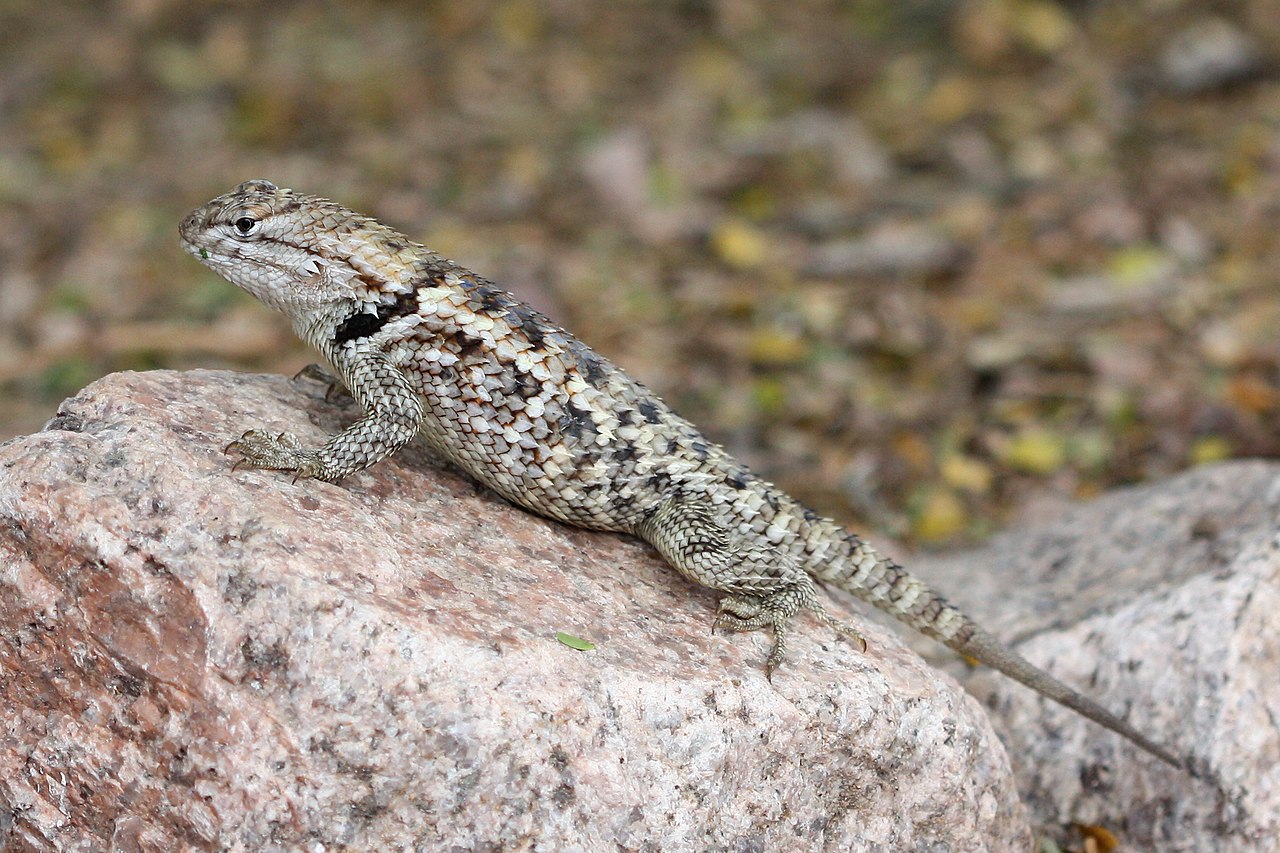
Scientific name: Sceloporus magister.
Common name: Desert spiny lizard.
The desert spiny lizard can grow up to 5.6 inches in body length, excluding the tail.
Males have blue to violet patches on their throat and belly and blue to green coloration on their sides and tails.
Females and juveniles have dark spots on their belly and back without any other coloration.
These lizards have the ability to darken in winter, which enables them to absorb more heat from the sun.
They lighten in summer, which enables them to reflect the sun.
Further Reading: